University Nursing Case Study Report: NURS1202, Semester 2
VerifiedAdded on 2022/11/13
|25
|4098
|34
Case Study
AI Summary
This case study report presents a comprehensive analysis of a 71-year-old female patient, addressing her medical history, current conditions (arthritis, dyskinesia, postural instability), medications, and lifestyle factors. The report details nursing assessments using the Barthel index and PDQ-39, revealing severe dependency and poor health. It includes a review of the patient's history, assessment of cues related to physiology, pharmacology and the identification of key nursing problems, such as arthritis and resting tremor. The study also proposes SMART goals for pain management and outlines nursing interventions, including analgesic therapy, with rationales based on relevant literature. The case study emphasizes the importance of clinical reasoning in the context of nursing practice and patient care.

Running head: CASE STUDY
Clinical reasoning cycle
Name of the Student
Name of the University
Author Note
Clinical reasoning cycle
Name of the Student
Name of the University
Author Note
Paraphrase This Document
Need a fresh take? Get an instant paraphrase of this document with our AI Paraphraser

CASE STUDY
Health History
Gender Male/Female
Age 71 years
Current Medical History
What current medical
conditions do you have?
Arthritis
Dyskinesia
Resting tremor
Postural instability
Past Medical/Surgical
History
What is you past
medical/surgical history?
Medical History
Have been diagnosed with
hypertension since 2002.
Normally in the range of
140/90 mm Hg.
Suffering from anxiety and
insomnia for the past 10
Surgical History
Underwent hip replacement
surgery where the painful hip
joint had been replaced with an
artificial joint
1 | P a g e
Health History
Gender Male/Female
Age 71 years
Current Medical History
What current medical
conditions do you have?
Arthritis
Dyskinesia
Resting tremor
Postural instability
Past Medical/Surgical
History
What is you past
medical/surgical history?
Medical History
Have been diagnosed with
hypertension since 2002.
Normally in the range of
140/90 mm Hg.
Suffering from anxiety and
insomnia for the past 10
Surgical History
Underwent hip replacement
surgery where the painful hip
joint had been replaced with an
artificial joint
1 | P a g e

CASE STUDY
years
Medications
What medications do you
take?
List medications and dosages (where possible)
30 mg Avinza (single dose, daily)
10 to 20 mg Kadian (single dose, daily)
25 mg orally Chlorthalidone (Hygroton) (once in a
day)
2.5-5 mg orally Methyclothiazide (Enduron) (once in
a day)
5 mg capsules orally Temazepam (Restoril)
10 mg orally Escitalopram (Lexapro) (once in a day)
Do you live alone/with
someone?
Alone/with someone
Daughter died 20 years ago
Are you able to care for
yourself?
Do you need help with
showering?
Do you need help with
toileting?
Yes/No
Yes/No
Yes/No
Yes/No
2 | P a g e
years
Medications
What medications do you
take?
List medications and dosages (where possible)
30 mg Avinza (single dose, daily)
10 to 20 mg Kadian (single dose, daily)
25 mg orally Chlorthalidone (Hygroton) (once in a
day)
2.5-5 mg orally Methyclothiazide (Enduron) (once in
a day)
5 mg capsules orally Temazepam (Restoril)
10 mg orally Escitalopram (Lexapro) (once in a day)
Do you live alone/with
someone?
Alone/with someone
Daughter died 20 years ago
Are you able to care for
yourself?
Do you need help with
showering?
Do you need help with
toileting?
Yes/No
Yes/No
Yes/No
Yes/No
2 | P a g e
⊘ This is a preview!⊘
Do you want full access?
Subscribe today to unlock all pages.

Trusted by 1+ million students worldwide
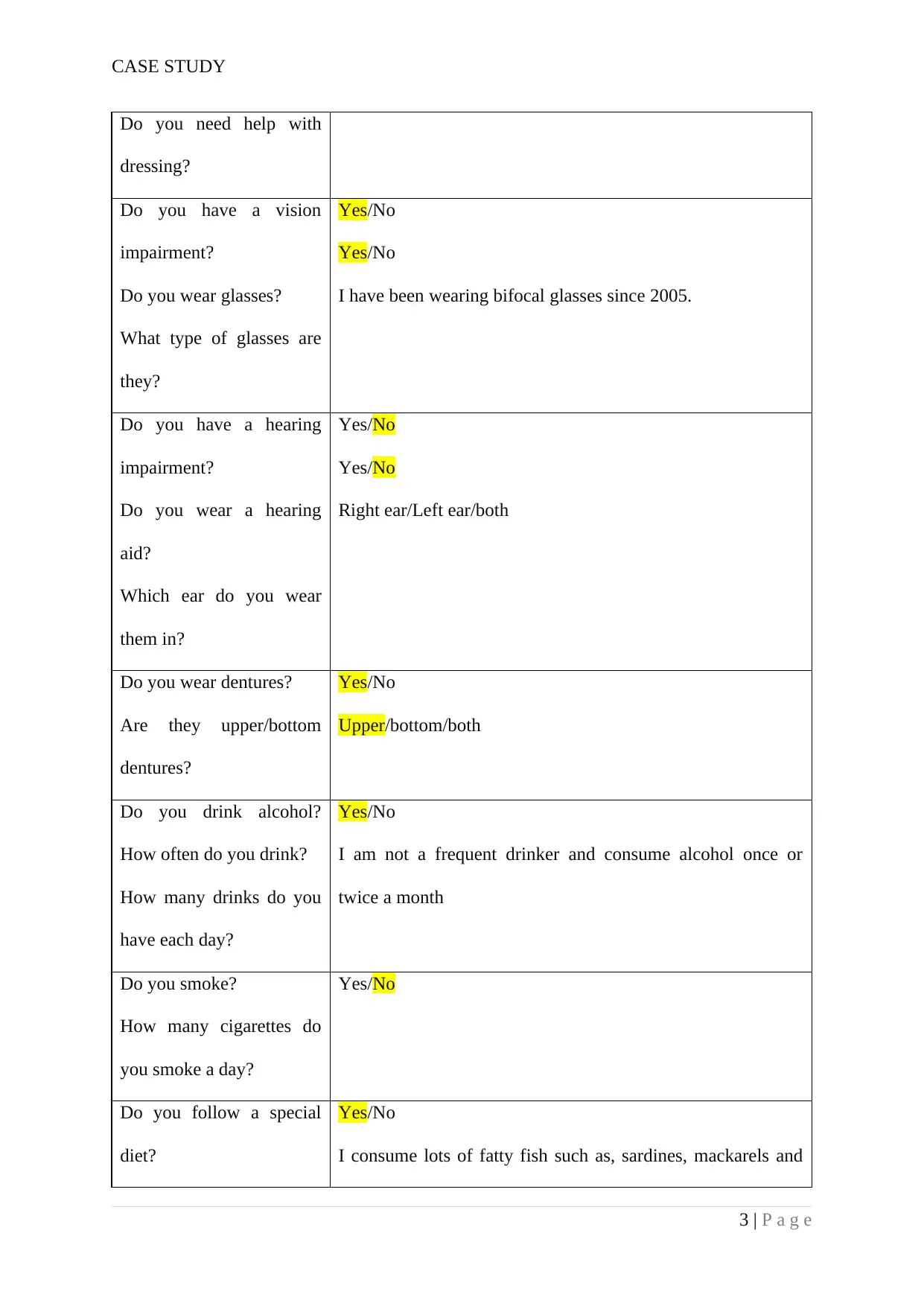
CASE STUDY
Do you need help with
dressing?
Do you have a vision
impairment?
Do you wear glasses?
What type of glasses are
they?
Yes/No
Yes/No
I have been wearing bifocal glasses since 2005.
Do you have a hearing
impairment?
Do you wear a hearing
aid?
Which ear do you wear
them in?
Yes/No
Yes/No
Right ear/Left ear/both
Do you wear dentures?
Are they upper/bottom
dentures?
Yes/No
Upper/bottom/both
Do you drink alcohol?
How often do you drink?
How many drinks do you
have each day?
Yes/No
I am not a frequent drinker and consume alcohol once or
twice a month
Do you smoke?
How many cigarettes do
you smoke a day?
Yes/No
Do you follow a special
diet?
Yes/No
I consume lots of fatty fish such as, sardines, mackarels and
3 | P a g e
Do you need help with
dressing?
Do you have a vision
impairment?
Do you wear glasses?
What type of glasses are
they?
Yes/No
Yes/No
I have been wearing bifocal glasses since 2005.
Do you have a hearing
impairment?
Do you wear a hearing
aid?
Which ear do you wear
them in?
Yes/No
Yes/No
Right ear/Left ear/both
Do you wear dentures?
Are they upper/bottom
dentures?
Yes/No
Upper/bottom/both
Do you drink alcohol?
How often do you drink?
How many drinks do you
have each day?
Yes/No
I am not a frequent drinker and consume alcohol once or
twice a month
Do you smoke?
How many cigarettes do
you smoke a day?
Yes/No
Do you follow a special
diet?
Yes/No
I consume lots of fatty fish such as, sardines, mackarels and
3 | P a g e
Paraphrase This Document
Need a fresh take? Get an instant paraphrase of this document with our AI Paraphraser
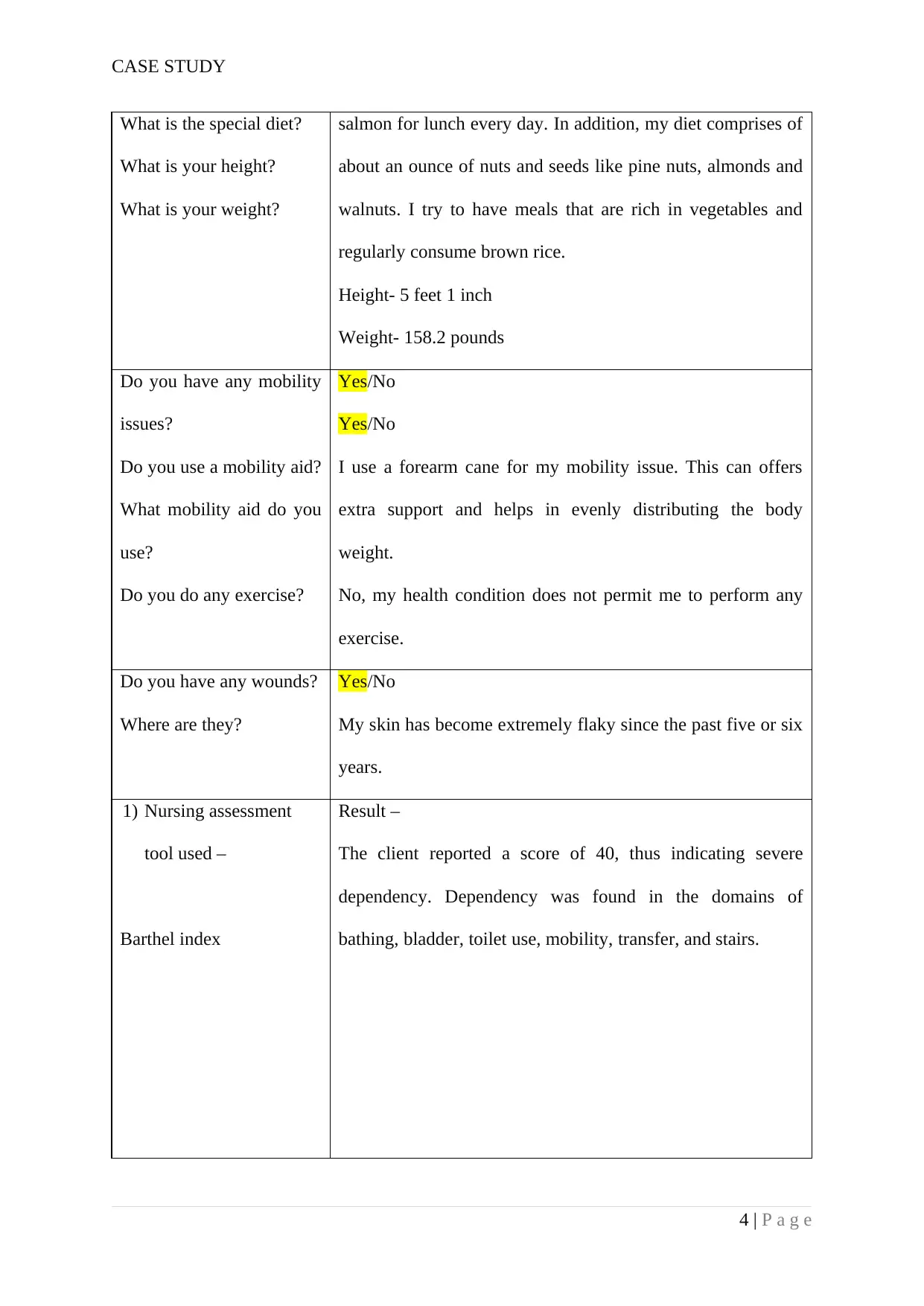
CASE STUDY
What is the special diet?
What is your height?
What is your weight?
salmon for lunch every day. In addition, my diet comprises of
about an ounce of nuts and seeds like pine nuts, almonds and
walnuts. I try to have meals that are rich in vegetables and
regularly consume brown rice.
Height- 5 feet 1 inch
Weight- 158.2 pounds
Do you have any mobility
issues?
Do you use a mobility aid?
What mobility aid do you
use?
Do you do any exercise?
Yes/No
Yes/No
I use a forearm cane for my mobility issue. This can offers
extra support and helps in evenly distributing the body
weight.
No, my health condition does not permit me to perform any
exercise.
Do you have any wounds?
Where are they?
Yes/No
My skin has become extremely flaky since the past five or six
years.
1) Nursing assessment
tool used –
Barthel index
Result –
The client reported a score of 40, thus indicating severe
dependency. Dependency was found in the domains of
bathing, bladder, toilet use, mobility, transfer, and stairs.
4 | P a g e
What is the special diet?
What is your height?
What is your weight?
salmon for lunch every day. In addition, my diet comprises of
about an ounce of nuts and seeds like pine nuts, almonds and
walnuts. I try to have meals that are rich in vegetables and
regularly consume brown rice.
Height- 5 feet 1 inch
Weight- 158.2 pounds
Do you have any mobility
issues?
Do you use a mobility aid?
What mobility aid do you
use?
Do you do any exercise?
Yes/No
Yes/No
I use a forearm cane for my mobility issue. This can offers
extra support and helps in evenly distributing the body
weight.
No, my health condition does not permit me to perform any
exercise.
Do you have any wounds?
Where are they?
Yes/No
My skin has become extremely flaky since the past five or six
years.
1) Nursing assessment
tool used –
Barthel index
Result –
The client reported a score of 40, thus indicating severe
dependency. Dependency was found in the domains of
bathing, bladder, toilet use, mobility, transfer, and stairs.
4 | P a g e
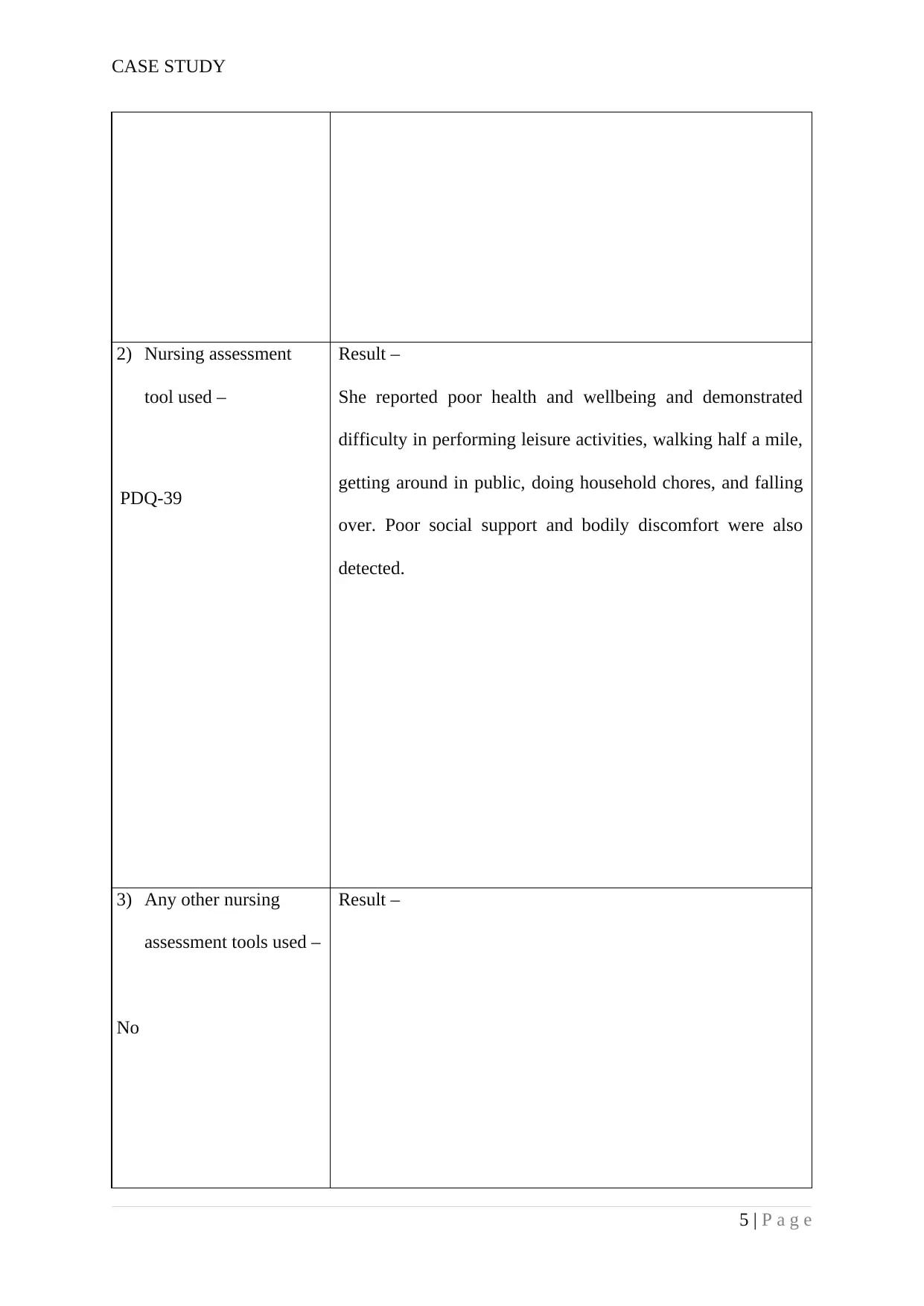
CASE STUDY
2) Nursing assessment
tool used –
PDQ-39
Result –
She reported poor health and wellbeing and demonstrated
difficulty in performing leisure activities, walking half a mile,
getting around in public, doing household chores, and falling
over. Poor social support and bodily discomfort were also
detected.
3) Any other nursing
assessment tools used –
No
Result –
5 | P a g e
2) Nursing assessment
tool used –
PDQ-39
Result –
She reported poor health and wellbeing and demonstrated
difficulty in performing leisure activities, walking half a mile,
getting around in public, doing household chores, and falling
over. Poor social support and bodily discomfort were also
detected.
3) Any other nursing
assessment tools used –
No
Result –
5 | P a g e
⊘ This is a preview!⊘
Do you want full access?
Subscribe today to unlock all pages.

Trusted by 1+ million students worldwide
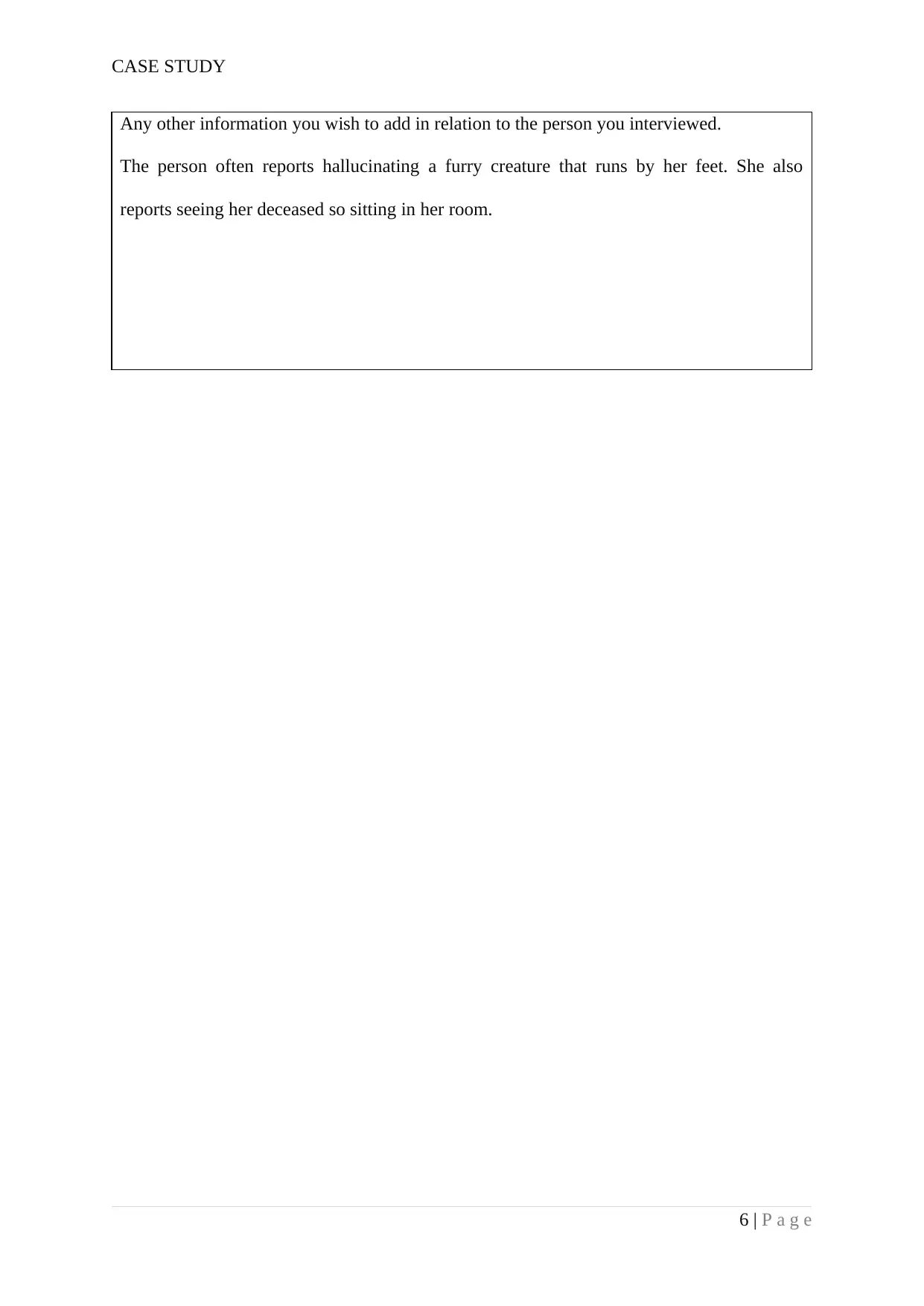
CASE STUDY
Any other information you wish to add in relation to the person you interviewed.
The person often reports hallucinating a furry creature that runs by her feet. She also
reports seeing her deceased so sitting in her room.
6 | P a g e
Any other information you wish to add in relation to the person you interviewed.
The person often reports hallucinating a furry creature that runs by her feet. She also
reports seeing her deceased so sitting in her room.
6 | P a g e
Paraphrase This Document
Need a fresh take? Get an instant paraphrase of this document with our AI Paraphraser
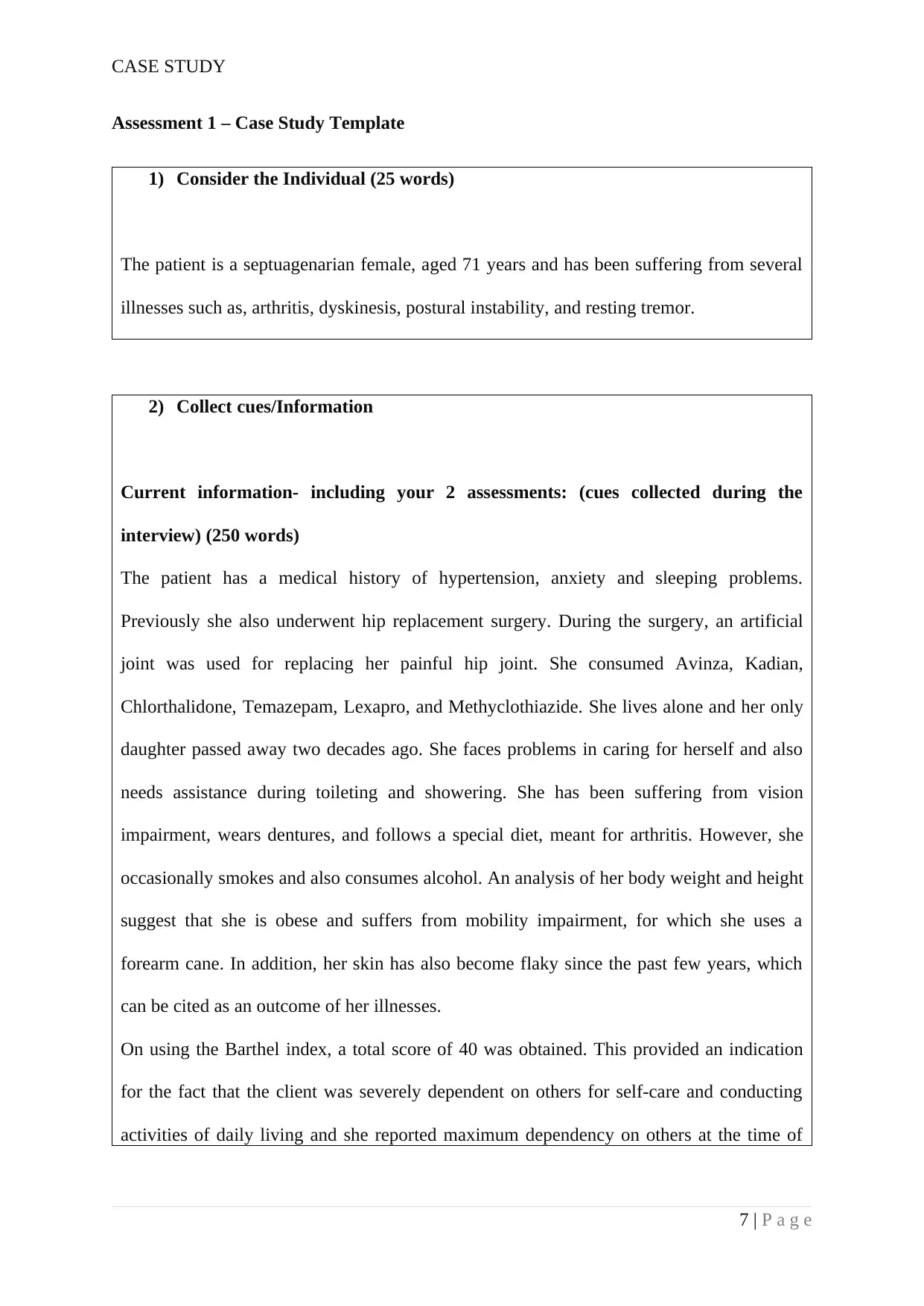
CASE STUDY
Assessment 1 – Case Study Template
1) Consider the Individual (25 words)
The patient is a septuagenarian female, aged 71 years and has been suffering from several
illnesses such as, arthritis, dyskinesis, postural instability, and resting tremor.
2) Collect cues/Information
Current information- including your 2 assessments: (cues collected during the
interview) (250 words)
The patient has a medical history of hypertension, anxiety and sleeping problems.
Previously she also underwent hip replacement surgery. During the surgery, an artificial
joint was used for replacing her painful hip joint. She consumed Avinza, Kadian,
Chlorthalidone, Temazepam, Lexapro, and Methyclothiazide. She lives alone and her only
daughter passed away two decades ago. She faces problems in caring for herself and also
needs assistance during toileting and showering. She has been suffering from vision
impairment, wears dentures, and follows a special diet, meant for arthritis. However, she
occasionally smokes and also consumes alcohol. An analysis of her body weight and height
suggest that she is obese and suffers from mobility impairment, for which she uses a
forearm cane. In addition, her skin has also become flaky since the past few years, which
can be cited as an outcome of her illnesses.
On using the Barthel index, a total score of 40 was obtained. This provided an indication
for the fact that the client was severely dependent on others for self-care and conducting
activities of daily living and she reported maximum dependency on others at the time of
7 | P a g e
Assessment 1 – Case Study Template
1) Consider the Individual (25 words)
The patient is a septuagenarian female, aged 71 years and has been suffering from several
illnesses such as, arthritis, dyskinesis, postural instability, and resting tremor.
2) Collect cues/Information
Current information- including your 2 assessments: (cues collected during the
interview) (250 words)
The patient has a medical history of hypertension, anxiety and sleeping problems.
Previously she also underwent hip replacement surgery. During the surgery, an artificial
joint was used for replacing her painful hip joint. She consumed Avinza, Kadian,
Chlorthalidone, Temazepam, Lexapro, and Methyclothiazide. She lives alone and her only
daughter passed away two decades ago. She faces problems in caring for herself and also
needs assistance during toileting and showering. She has been suffering from vision
impairment, wears dentures, and follows a special diet, meant for arthritis. However, she
occasionally smokes and also consumes alcohol. An analysis of her body weight and height
suggest that she is obese and suffers from mobility impairment, for which she uses a
forearm cane. In addition, her skin has also become flaky since the past few years, which
can be cited as an outcome of her illnesses.
On using the Barthel index, a total score of 40 was obtained. This provided an indication
for the fact that the client was severely dependent on others for self-care and conducting
activities of daily living and she reported maximum dependency on others at the time of
7 | P a g e
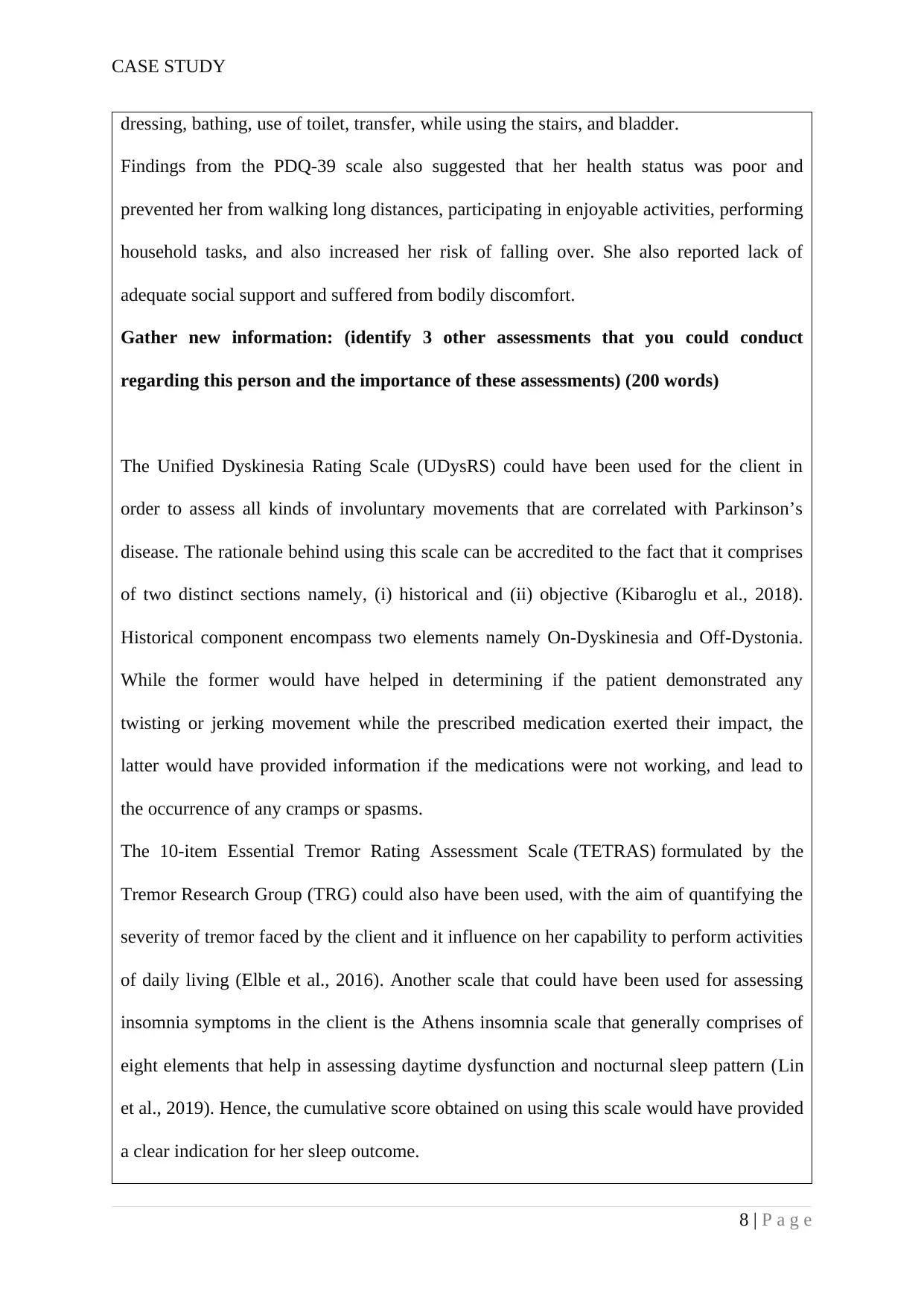
CASE STUDY
dressing, bathing, use of toilet, transfer, while using the stairs, and bladder.
Findings from the PDQ-39 scale also suggested that her health status was poor and
prevented her from walking long distances, participating in enjoyable activities, performing
household tasks, and also increased her risk of falling over. She also reported lack of
adequate social support and suffered from bodily discomfort.
Gather new information: (identify 3 other assessments that you could conduct
regarding this person and the importance of these assessments) (200 words)
The Unified Dyskinesia Rating Scale (UDysRS) could have been used for the client in
order to assess all kinds of involuntary movements that are correlated with Parkinson’s
disease. The rationale behind using this scale can be accredited to the fact that it comprises
of two distinct sections namely, (i) historical and (ii) objective (Kibaroglu et al., 2018).
Historical component encompass two elements namely On-Dyskinesia and Off-Dystonia.
While the former would have helped in determining if the patient demonstrated any
twisting or jerking movement while the prescribed medication exerted their impact, the
latter would have provided information if the medications were not working, and lead to
the occurrence of any cramps or spasms.
The 10-item Essential Tremor Rating Assessment Scale (TETRAS) formulated by the
Tremor Research Group (TRG) could also have been used, with the aim of quantifying the
severity of tremor faced by the client and it influence on her capability to perform activities
of daily living (Elble et al., 2016). Another scale that could have been used for assessing
insomnia symptoms in the client is the Athens insomnia scale that generally comprises of
eight elements that help in assessing daytime dysfunction and nocturnal sleep pattern (Lin
et al., 2019). Hence, the cumulative score obtained on using this scale would have provided
a clear indication for her sleep outcome.
8 | P a g e
dressing, bathing, use of toilet, transfer, while using the stairs, and bladder.
Findings from the PDQ-39 scale also suggested that her health status was poor and
prevented her from walking long distances, participating in enjoyable activities, performing
household tasks, and also increased her risk of falling over. She also reported lack of
adequate social support and suffered from bodily discomfort.
Gather new information: (identify 3 other assessments that you could conduct
regarding this person and the importance of these assessments) (200 words)
The Unified Dyskinesia Rating Scale (UDysRS) could have been used for the client in
order to assess all kinds of involuntary movements that are correlated with Parkinson’s
disease. The rationale behind using this scale can be accredited to the fact that it comprises
of two distinct sections namely, (i) historical and (ii) objective (Kibaroglu et al., 2018).
Historical component encompass two elements namely On-Dyskinesia and Off-Dystonia.
While the former would have helped in determining if the patient demonstrated any
twisting or jerking movement while the prescribed medication exerted their impact, the
latter would have provided information if the medications were not working, and lead to
the occurrence of any cramps or spasms.
The 10-item Essential Tremor Rating Assessment Scale (TETRAS) formulated by the
Tremor Research Group (TRG) could also have been used, with the aim of quantifying the
severity of tremor faced by the client and it influence on her capability to perform activities
of daily living (Elble et al., 2016). Another scale that could have been used for assessing
insomnia symptoms in the client is the Athens insomnia scale that generally comprises of
eight elements that help in assessing daytime dysfunction and nocturnal sleep pattern (Lin
et al., 2019). Hence, the cumulative score obtained on using this scale would have provided
a clear indication for her sleep outcome.
8 | P a g e
⊘ This is a preview!⊘
Do you want full access?
Subscribe today to unlock all pages.

Trusted by 1+ million students worldwide

CASE STUDY
Recall (using literature identify and describe 3 cues in relation to physiology,
pathophysiology, pharmacology, epidemiology, therapeutics, contexts of care or ethics
that will assist you to further understand this personal health) (300 words)
Three major cues obtained during the interview are namely, (i) arthritis, (ii) postural
instability, and (iii) dyskinesia. Arthritis refers to the degenerative joint illness that results
in morphological damage and loss of the gross cartilage, followed by a range of
biochemical changes. In a healthy person, the compressive force that drives the water out,
in addition to the osmotic and hydrostatic pressure that draw the water in help in
maintaining the water content inside the cartilage (Herrero-Beaumont et al. 2017).
However, in the client, disorganisation of the collagen matrix resulted in a reduction in the
content of proteoglycan, thus increasing the water content and causing inflammation in the
synovium, thereby leading to pain in the joints. Dyskinesia typically refers to a movement
disorder that is primarily characterised by involuntary movement of the muscles, such as
chorea or tics (Pérez-Ortega et al., 2016). However, the condition can be cited as a direct
consequence of long term administration of Lexapro, an antipsychotic medication, which
9 | P a g e
Recall (using literature identify and describe 3 cues in relation to physiology,
pathophysiology, pharmacology, epidemiology, therapeutics, contexts of care or ethics
that will assist you to further understand this personal health) (300 words)
Three major cues obtained during the interview are namely, (i) arthritis, (ii) postural
instability, and (iii) dyskinesia. Arthritis refers to the degenerative joint illness that results
in morphological damage and loss of the gross cartilage, followed by a range of
biochemical changes. In a healthy person, the compressive force that drives the water out,
in addition to the osmotic and hydrostatic pressure that draw the water in help in
maintaining the water content inside the cartilage (Herrero-Beaumont et al. 2017).
However, in the client, disorganisation of the collagen matrix resulted in a reduction in the
content of proteoglycan, thus increasing the water content and causing inflammation in the
synovium, thereby leading to pain in the joints. Dyskinesia typically refers to a movement
disorder that is primarily characterised by involuntary movement of the muscles, such as
chorea or tics (Pérez-Ortega et al., 2016). However, the condition can be cited as a direct
consequence of long term administration of Lexapro, an antipsychotic medication, which
9 | P a g e
Paraphrase This Document
Need a fresh take? Get an instant paraphrase of this document with our AI Paraphraser
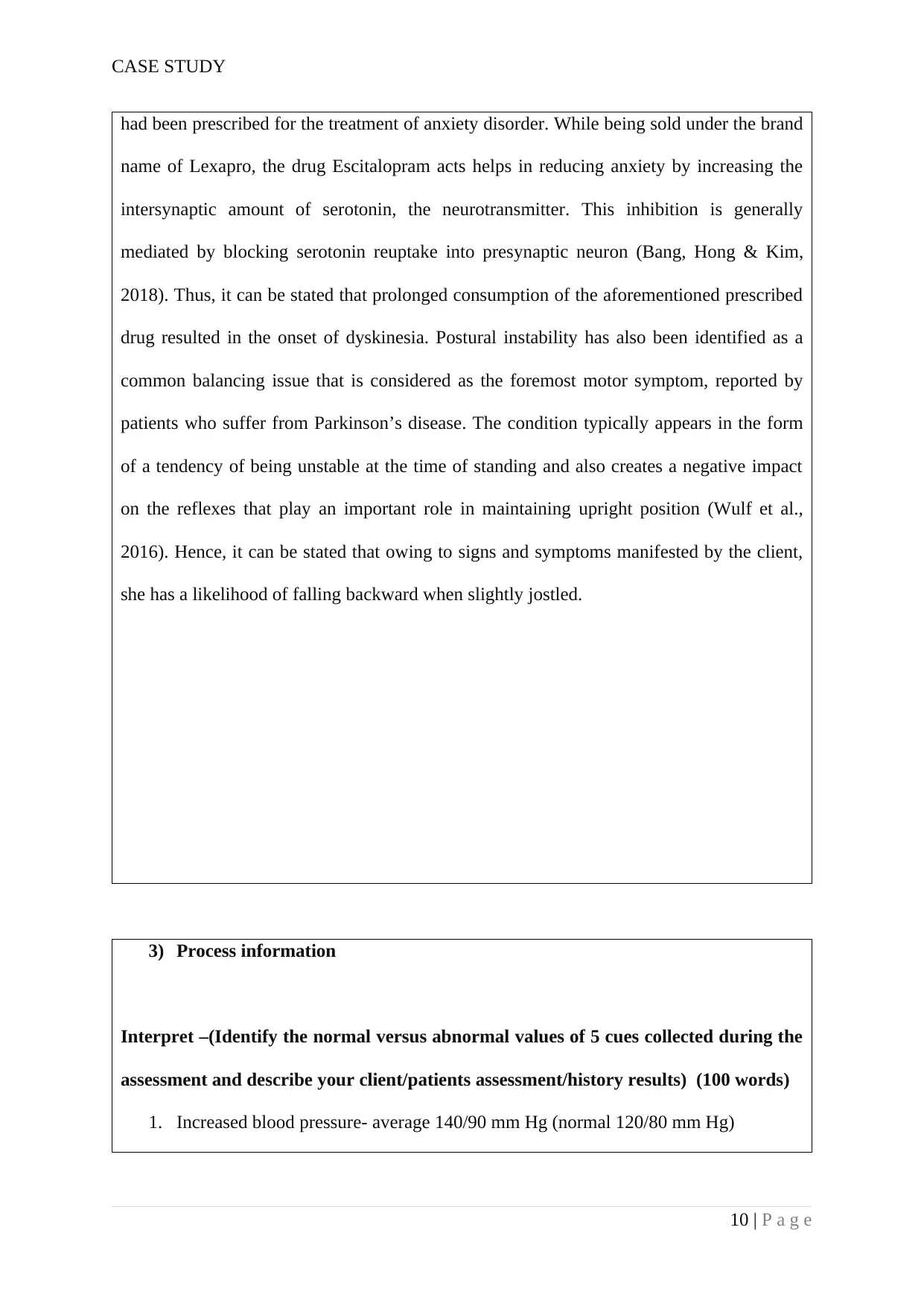
CASE STUDY
had been prescribed for the treatment of anxiety disorder. While being sold under the brand
name of Lexapro, the drug Escitalopram acts helps in reducing anxiety by increasing the
intersynaptic amount of serotonin, the neurotransmitter. This inhibition is generally
mediated by blocking serotonin reuptake into presynaptic neuron (Bang, Hong & Kim,
2018). Thus, it can be stated that prolonged consumption of the aforementioned prescribed
drug resulted in the onset of dyskinesia. Postural instability has also been identified as a
common balancing issue that is considered as the foremost motor symptom, reported by
patients who suffer from Parkinson’s disease. The condition typically appears in the form
of a tendency of being unstable at the time of standing and also creates a negative impact
on the reflexes that play an important role in maintaining upright position (Wulf et al.,
2016). Hence, it can be stated that owing to signs and symptoms manifested by the client,
she has a likelihood of falling backward when slightly jostled.
3) Process information
Interpret –(Identify the normal versus abnormal values of 5 cues collected during the
assessment and describe your client/patients assessment/history results) (100 words)
1. Increased blood pressure- average 140/90 mm Hg (normal 120/80 mm Hg)
10 | P a g e
had been prescribed for the treatment of anxiety disorder. While being sold under the brand
name of Lexapro, the drug Escitalopram acts helps in reducing anxiety by increasing the
intersynaptic amount of serotonin, the neurotransmitter. This inhibition is generally
mediated by blocking serotonin reuptake into presynaptic neuron (Bang, Hong & Kim,
2018). Thus, it can be stated that prolonged consumption of the aforementioned prescribed
drug resulted in the onset of dyskinesia. Postural instability has also been identified as a
common balancing issue that is considered as the foremost motor symptom, reported by
patients who suffer from Parkinson’s disease. The condition typically appears in the form
of a tendency of being unstable at the time of standing and also creates a negative impact
on the reflexes that play an important role in maintaining upright position (Wulf et al.,
2016). Hence, it can be stated that owing to signs and symptoms manifested by the client,
she has a likelihood of falling backward when slightly jostled.
3) Process information
Interpret –(Identify the normal versus abnormal values of 5 cues collected during the
assessment and describe your client/patients assessment/history results) (100 words)
1. Increased blood pressure- average 140/90 mm Hg (normal 120/80 mm Hg)
10 | P a g e
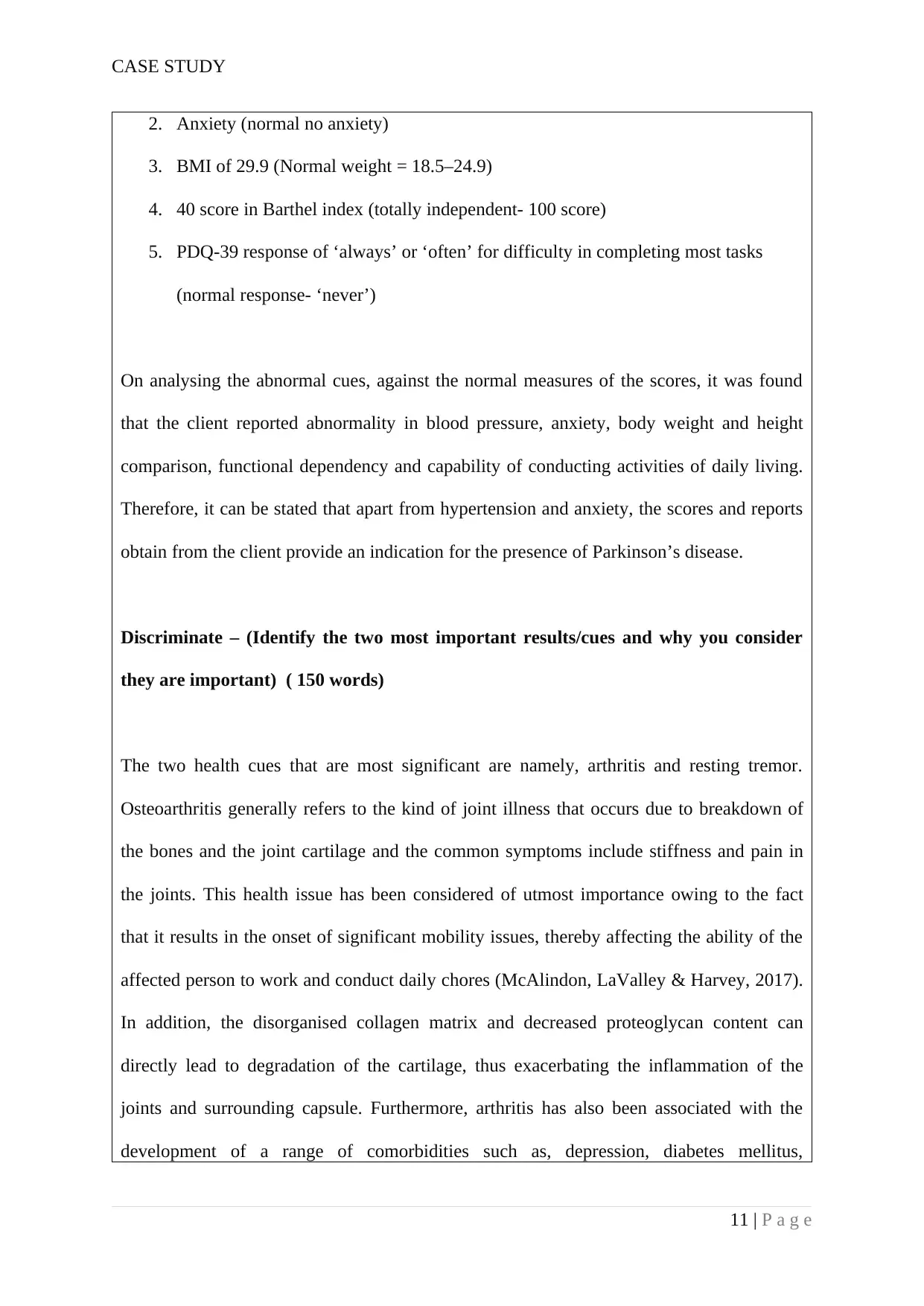
CASE STUDY
2. Anxiety (normal no anxiety)
3. BMI of 29.9 (Normal weight = 18.5–24.9)
4. 40 score in Barthel index (totally independent- 100 score)
5. PDQ-39 response of ‘always’ or ‘often’ for difficulty in completing most tasks
(normal response- ‘never’)
On analysing the abnormal cues, against the normal measures of the scores, it was found
that the client reported abnormality in blood pressure, anxiety, body weight and height
comparison, functional dependency and capability of conducting activities of daily living.
Therefore, it can be stated that apart from hypertension and anxiety, the scores and reports
obtain from the client provide an indication for the presence of Parkinson’s disease.
Discriminate – (Identify the two most important results/cues and why you consider
they are important) ( 150 words)
The two health cues that are most significant are namely, arthritis and resting tremor.
Osteoarthritis generally refers to the kind of joint illness that occurs due to breakdown of
the bones and the joint cartilage and the common symptoms include stiffness and pain in
the joints. This health issue has been considered of utmost importance owing to the fact
that it results in the onset of significant mobility issues, thereby affecting the ability of the
affected person to work and conduct daily chores (McAlindon, LaValley & Harvey, 2017).
In addition, the disorganised collagen matrix and decreased proteoglycan content can
directly lead to degradation of the cartilage, thus exacerbating the inflammation of the
joints and surrounding capsule. Furthermore, arthritis has also been associated with the
development of a range of comorbidities such as, depression, diabetes mellitus,
11 | P a g e
2. Anxiety (normal no anxiety)
3. BMI of 29.9 (Normal weight = 18.5–24.9)
4. 40 score in Barthel index (totally independent- 100 score)
5. PDQ-39 response of ‘always’ or ‘often’ for difficulty in completing most tasks
(normal response- ‘never’)
On analysing the abnormal cues, against the normal measures of the scores, it was found
that the client reported abnormality in blood pressure, anxiety, body weight and height
comparison, functional dependency and capability of conducting activities of daily living.
Therefore, it can be stated that apart from hypertension and anxiety, the scores and reports
obtain from the client provide an indication for the presence of Parkinson’s disease.
Discriminate – (Identify the two most important results/cues and why you consider
they are important) ( 150 words)
The two health cues that are most significant are namely, arthritis and resting tremor.
Osteoarthritis generally refers to the kind of joint illness that occurs due to breakdown of
the bones and the joint cartilage and the common symptoms include stiffness and pain in
the joints. This health issue has been considered of utmost importance owing to the fact
that it results in the onset of significant mobility issues, thereby affecting the ability of the
affected person to work and conduct daily chores (McAlindon, LaValley & Harvey, 2017).
In addition, the disorganised collagen matrix and decreased proteoglycan content can
directly lead to degradation of the cartilage, thus exacerbating the inflammation of the
joints and surrounding capsule. Furthermore, arthritis has also been associated with the
development of a range of comorbidities such as, depression, diabetes mellitus,
11 | P a g e
⊘ This is a preview!⊘
Do you want full access?
Subscribe today to unlock all pages.

Trusted by 1+ million students worldwide
1 out of 25
Related Documents
Your All-in-One AI-Powered Toolkit for Academic Success.
+13062052269
info@desklib.com
Available 24*7 on WhatsApp / Email
![[object Object]](/_next/static/media/star-bottom.7253800d.svg)
Unlock your academic potential
Copyright © 2020–2025 A2Z Services. All Rights Reserved. Developed and managed by ZUCOL.





